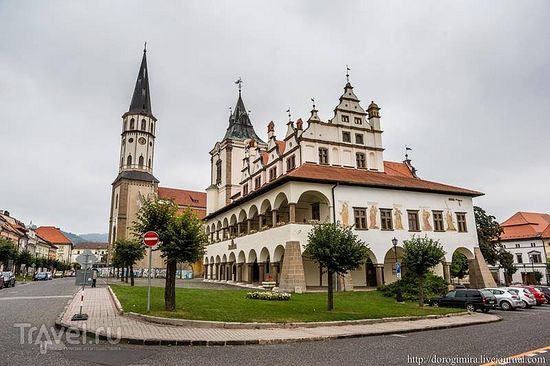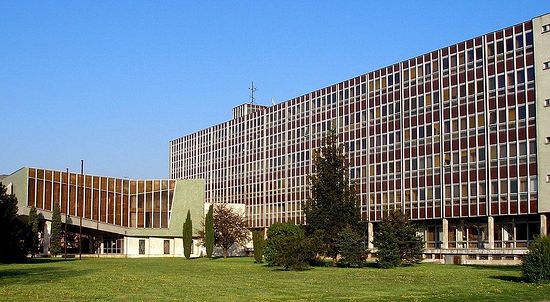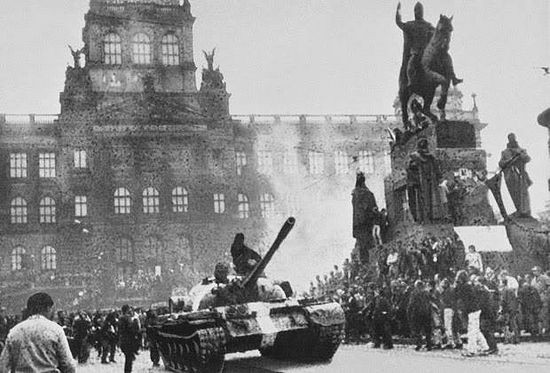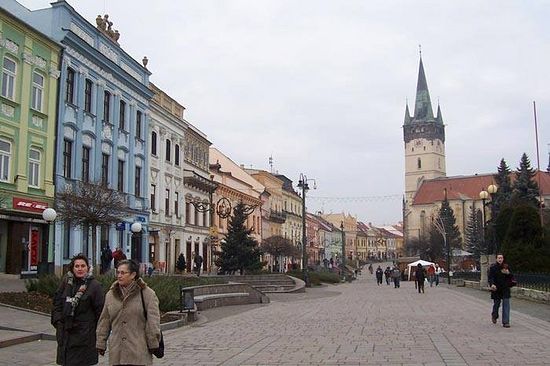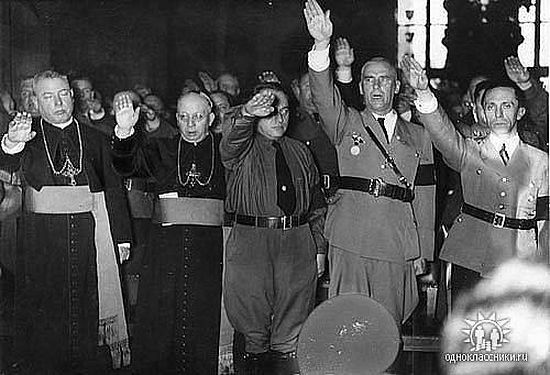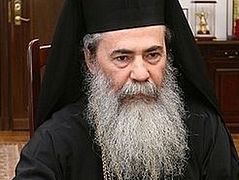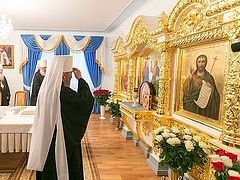I was able to talk with Fr. Stephan after his report at the Mukachevo1 International conference entitled, “Little Mt. Athos—Monasteries and Monasticism in the Carpathians: Traditions and Modernity,” which he gave on the theme of Church and state relations during various historical periods. Using documented facts, the scholarly theologian illustrated how any interference by the state in the life of the Church, as a rule, brings irreparable harm. In his report he also emphasized that the Church’s apolitical nature is a necessary condition for its healthy spiritual life. To us this theme seemed to be especially relevant to the current situation in the Ukraine, and the activities of the schismatics and their political adherents.
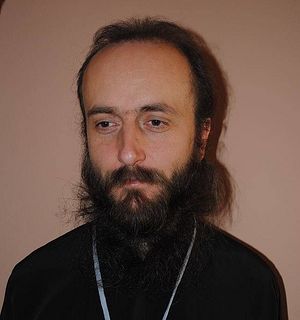
The family of Fr. Stephan Pruzhinsky (senior) lived in an ancient, picturesque city in East Slovakia at the foot of Levoča Hills, not far from the Spiš Castle. There amidst the abundant ancient Catholic churches was an Orthodox church, where Fr. Stephan senior served. Historically the Orthodox have and still do inhabit the eastern part of Slovakia bordering the Mukachevo diocese of which it was once a part. Today over 50,000 Orthodox live on the territory of Slovakia, mainly Rusyns (Carpatho-Russians) and their descendants, in the northeast part of the country.
Then his family moved to Prešov, where an Orthodox theological department was established in the local university—the former Prague and Karlovy Vary theological seminary transferred in 1950, where Fr. Stephan (senior) served, and then where his son, Fr. Stephan, studied and is now the dean. Fr. Stephan has a large Orthodox family—five children who he is raising with his life companion, Matushka Tatiana. The oldest son is eighteen, and the youngest daughter is two and a half. Fr. Stephan (senior) is still alive, and recently celebrated his eightieth birthday.
Concerning this historical moment when the seminary was converted into a university department, Fr. Stephan explained that the faculty moved to Prešov when the Uniates of Eastern Slovakia reunited with the Orthodox, and the problem of theologically educating the former Greek Catholics became particularly relevant.
In Prešov the department was relocated to the building were there was once a Greek Catholic academy, which existed from 1880 to 1950 when it was closed and its students dismissed. In 1968, when the Greek Catholic Church was restored, there was an unsuccessful attempt made to restore its educational structure in Eastern Slovakia. Uniate students were accepted for study in very small numbers (two to three students per year) at the Sts. Cyril and Methodius Roman Catholic theological department in Bratislav.
There was a reason why Fr. Stephan cited these historical details. In 1968, in what was then socialist Czechoslovakia, there were waves of political shake-ups connected with the government’s course of reform aimed at separating from the post-war Eastern Block countries of the Warsaw Pact. This went down in history as the “Prague Spring of 1968”.2
Participating in this process were also radical Czechoslovakian dissident nationalists, which included underground Uniate activists. They were the ones who labeled the Orthodox in Czechoslovakia as “pro-Russian” and “pro-Kremlin”, although the Orthodox Church in the Czech lands and Slovakia in 1950 had received the status of a Local Autocephaly, and had no relation to politics in the least. (These ideas live on to this day.—Auth.)
The nationalists made a list of Orthodox clergy, numbered them among the “enemies of the people” and sentenced them to “liquidation”. His father ended up on this list. Some Orthodox brothers who got hold of the execution list warned Fr. Stephan of the murderers’ ill intentions and helped the priest and his family hide temporarily to avoid this act of vengeance. Nevertheless, the bandits did attack some Orthodox parishes, beat the clergy with stones, threw them out of their homes and churches, and even shed innocent blood—they killed the son of an Orthodox priest who lived in the village of Uli.
Several months afterwards, the political coupe was liquidated the police stopped the terrorist group of nationalists.
Listening to Fr. Stephan we were involuntarily convinced of how the history of Orthodoxy in those lands was bore the character of confession of faith, including in the newer Transcarpathian and Carpathian regions. To them apply the Teacher’s words in the Sermon on the Mount: Blessed are ye, when men shall revile you, and persecute you, and shall say all manner of evil against you falsely, for my sake (Mt. 5:11).
Perhaps these now distant events made the future theologian, who was born six years after the events happened (1974) but heard about them from the older generation, start contemplating the relationship between Church and state in various historical eras and under various political establishments, and also the participation in these processes by religious-political groups.
We continued our conversation.
—Tell us, Fr. Stephan, how did the relationship between the Orthodox of your generation and the current government finally come together?
—Thank God, compared to 1968 the situation is much better. However the children of Orthodox parents did experience some repression from the communists. For example, in schools they would ask all those who were not baptized to raise their hands. There would only be one or two in the class, but they would be encouraged, praised, and held up as examples of true builders of communism, and as conscious and beneficial to society. Because I was the son of a priest they tried to prevent me from receiving a special middle and higher education. True, other teachers protected me because I was a good student, and then my father came to the school and with God’s help found the words to make them stop hindering me from continuing my education as I saw fit. And so I entered the theological department of Prešov University as well as in Greece, as I had studied the Greek language in the philosophy department.
—The theme of your report at the International theological conference in Mukachevo was, “Apolitical stance and the relationship between Church and state in Orthodox Church tradition.” Obviously you have been studying this subject for a long time?
—The aim of my talk was to show that in the history of the Church from Old Testament times to our own times there have been many examples of cruel and violent repressions against Christianity, when various individuals in the government as well as on the level of the Church mixed ecclesiastical matters with political ones, and this always brought lamentable results. These processes were always bad for the Church.
—Is there some theological term that would characterize the state’s interference in the life of the Church?
—Perhaps it would be, “caesaropapism”… This relationship between the Church and the state, in which secular authorities have primacy over the spiritual authorities, and a political leader—this can also be a dictator—is given in addition to his absolute secular authority, “sacred” functions.
—And under modern conditions?
—It is just as dangerous. Religious-political symbiosis often bears in itself aggression and militarism, and is the cause of wars of varying scales.
The state should not interfere in religious life; this has been proven by history. Nor should the Church unite with politics. Christ’s Church, the Orthodox Church, walking the path of love, is always in a condition in which it can resolve one or another intra-ecclesiastical problem through peaceful means and witness the truth to the world. The many free autocephalous canonical Churches, as well as autonomous ones like the Ukrainian Church, which all together are the One Catholic and Apostolic Church, is an illustration of this.
—How would you evaluate the situation in the Ukraine in connection with the schism caused by the so-called Ukrainian Orthodox Church, Kiev Patriarchate?
—Of course, schism is a very dangerous and harmful thing. Schism is as a rule the precursor to new heresies. If the schism is not overcome with time and the broken-off part does not return to the bosom of the Church, then this as a rule causes a heresy to be born.
—For example?
—For example, the Roman Patriarchate at first broke off, lost grace, and then fell into heresy and dogmatic distortions. All the sects that fell away from Orthodoxy also came about by way of schism. The main reason for schism is pride, not wanting to be humble, due to personal ambitions or political interests. The holy fathers say, “Whoever desires schism will never see the Heavenly Kingdom.”
—In conclusion: What then is the proper relationship between Church and state?
—The main manifestation of symphony of Church and state consists in each organization fulfilling its service as best it can, according to the Gospel commandments. So that the government would do its public job, and the Church would do its spiritual work, and so that between them would be a calm, peaceful coexistence without interference in each other’s affairs. One theologian said that symphony comes about when at least two voices are heard. If one voice talks while the other is silent, there can be no symphony. The opposite is also true—if one talks and the other only repeats the first, this is also not symphony. Symphony happens when each one is speaking with its own, free voice.
* * *
Christianity was established on the territory of modern day Czechia and Slovakia back in the ninth century. The mass baptism of the peoples in Greater Moravia began in 863, from the time that the equal-to-the-apostles brothers Cyril and Methodius arrived in the country. In around 874, the Czech prince Borivoi and his wife Liudmila (+929) received Baptism from St. Methodius, and subsequently established Orthodoxy in Czechia, and ending their lives as martyrs.
The Church has its own especially venerated saints: St. John of Czechia (+883), who labored ascetically for forty-two years in reclusion; the martyr Prince Vaclav (Wenceslas) (+929), glorified for his mercy and the building of churches; St. Procopius of Sázava (+1053), a great ascetic who held sacred the ancient inheritance of Sts. Cyril and Methodius. In the twentieth century, Holy Hierarch Gorazd (Pavlik) renewed Orthodoxy in the Czech lands, and died martyrically in 1942 and the hands of the fascists.
The Serbian Church in 1948 officially announced its concurrence with the Autonomous Czech diocese’s joining the Moscow Patriarchate. In 1951, the Russian Orthodox Church granted autocephaly to the Orthodox Church in Czechia and Slovakia.

